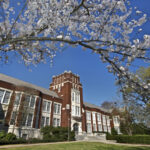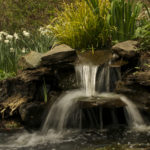Mount Washington Arboretum
From lunar landscape to lush urban oasis
Thousands of forgotten lots dot urban landscapes nationwide. While many are pegged for improvement, dwindling municipal resources mean many remain empty eyesores. The one-acre piece of land that is now Mt. Washington Arboretum in Baltimore was one such space. It laid vacant for years until a pediatrician with a passion for plants rallied his neighbors, raised funds and revitalized the plot.
Starting with a lunar landscape
Longtime Mt. Washington resident and nature lover Mike Sherlock began improving the public spaces in his neighborhood as a hobby. He was a pediatrician, but his mother was an avid gardener who instilled her love of gardening in him. Soon his neighborhood association asked him to chair a committee on beautifying other neighborhood areas.

Slowly but surely, he and fellow Mt. Washington Improvement Association volunteers beautified every inch of public space in their neighborhood but one large area. Once a garden apartment complex with tennis courts and a swimming pool, this one-acre lot had been wiped out by a hurricane and condemned. When the city cleared it and used heavy equipment to install a sewer line, the soil became so compacted it was impossible for plants to establish roots.
Mike likened the lot to a lunar landscape and hesitated to tackle such a big project. But, after much discussion, and with the support of his neighborhood association and Nature Sacred, he and fellow volunteers dug in.
Blank canvas for planting
Their goal was to transform this desolate acre into a thriving habitat for native plants and animals and an inviting oasis for the community to enjoy using ecologically sound practices. These included composting, recycling garden waste, green roofs, rain barrels and sustainable irrigation. They hoped to use the space to educate visitors on the value and beauty of a natural habitat in a city environment.
But first they had to create a nutrient-rich layer of topsoil over the dense, debris-ridden dirt. It takes 100 years to create an inch of topsoil in a forest organically. Mike and his volunteers fast-tracked this by carrying in hundreds of bags of mulch and layering on several inches of leaves.

There are now over 300 species of trees, shrubs and flowers flourishing in Mt. Washington Arboretum. Mike and his volunteers chose plants with three-season interest. For example, viburnum flowers in the spring, providing nectar for butterflies. Its leaves turn yellow and orange in the fall, contrasting with the evergreens planted. And it produces berries in the winter, providing food for birds.
Over 300 yards of trails wind through the one-acre space to provide a sense of mystery about what lies beyond the next turn. Five benches dot different areas for visitors to pause along their walks. And our signature Nature Sacred bench and journal is in an open circular area that invites groups to gather.
Water water everywhere
A 3,500-gallon pond with a waterfall serves as a gathering place for fish, frogs, water bugs, birds, butterflies and dragonflies. As water is always an issue for gardeners, and a growing concern for society with potential future effects of global warming, Mt. Washington Arboretum features a natural watering system for sustainable irrigation.

The system pulls rainwater from the gutter of a nearby house, down a hill and through an aqueduct that empties into a series of connected barrels. When one barrel fills, it overflows into the next. From there, the water flows into another aqueduct and empties like a waterfall into a water storage unit. A half inch of rain produces about 600 gallons of water for the storage unit, and hoses feed water to the field when needed. The water containment area has a green roof, and a mini version demonstrates to visitors how to build their own, using shale and hardy sedum.

Education and inspiration for all
Indeed, Mt. Washington Arboretum has become a valued community resource. A teaching pavilion is used for all kinds of classes and programs, ranging from creating a native plant garden to controlling deer to making and using rain barrels. With many plants and trees identified on plaques by their common and botanical names, the arboretum is a school field trip destination.
What lessons do butterflies have to teach? Beauty and grace is around and inside all the time.
— Dr. Mike Sherlock
Kids and young adults come to do community service. Painters and photographers use the natural setting for inspiration. Master gardeners and nature groups come to learn. Mothers bring their children, teens stop after school–and two couples even got married on its grounds. The also holds summer and winter solstice celebrations and Halloween parties each year.

Nature is good medicine
Mike learned a lot from working on this project. He realized there was another aspect of the garden he wasn’t fully aware of until people pointed it out—the spiritual dimension. Many said things such as, “I love it here. It’s so spiritual.”
He believes this acre of beauty has strengthened the community, bringing volunteers together and giving visitors a chance to disconnect from their busy lives and reconnect with the natural rhythm of life.
So much can go wrong in this world that you have no impact on. But, in the garden, you can do something right. You can create beauty in a world that’s often ugly and disorderly. The garden puts you back in touch with the natural world and the natural order of things.
– Dr. Mike Sherlock
He also adds:
A woman once stopped and asked me if I was doing this out of the goodness of my heart. The answer came to me. I, along with many others, am doing this for the good of my own heart. It’s something I feel a deep need to do in a world that has grown increasingly materialistic and divorced from the natural world and from beauty in general. The arboretum is something I do because it fills my heart—and hopefully the hearts of all who come to visit.




